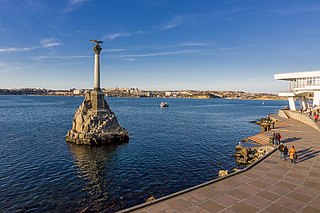
Sevastopol, sometimes written Sebastopol, is the largest city in Crimea, and a major port on the Black Sea. Due to its strategic location and the navigability of the city's harbours, Sevastopol has been an important port and naval base throughout its history. Since the city's founding in 1783 it has been a major base for Russia's Black Sea Fleet, and it was previously a closed city during the Cold War. The total administrative area is 864 square kilometres (334 sq mi) and includes a significant amount of rural land. The urban population, largely concentrated around Sevastopol Bay, is 479,394, and the total population is 547,820.

The Tatars is an umbrella term for different Turkic ethnic groups bearing the name "Tatar". Initially, the ethnonym Tatar possibly referred to the Tatar confederation. That confederation was eventually incorporated into the Mongol Empire when Genghis Khan unified the various steppe tribes. Historically, the term Tatars was applied to anyone originating from the vast Northern and Central Asian landmass then known as Tartary, a term which was also conflated with the Mongol Empire itself. More recently, however, the term has come to refer more narrowly to related ethnic groups who refer to themselves as Tatars or who speak languages that are commonly referred to as Tatar.

Crimea is a peninsula in Ukraine, on the northern coast of the Black Sea, that has been occupied by Russia since 2014. It has a population of 2.4 million. The peninsula is almost entirely surrounded by the Black Sea and the smaller Sea of Azov. The Isthmus of Perekop connects the peninsula to Kherson Oblast in mainland Ukraine. To the east, the Crimean Bridge, constructed in 2018, spans the Strait of Kerch, linking the peninsula with Krasnodar Krai in Russia. The Arabat Spit, located to the northeast, is a narrow strip of land that separates the Sivash lagoons from the Sea of Azov. Across the Black Sea to the west lies Romania and to the south is Turkey.

Yalta is a resort city on the south coast of the Crimean Peninsula in Ukraine surrounded by the Black Sea. It serves as the administrative center of Yalta Municipality, one of the regions within Crimea. Yalta, along with the rest of Crimea, is internationally recognised as part of Ukraine, and is considered part of the Autonomous Republic of Crimea. However, it is occupied by Russia, which annexed Crimea in 2014 and regards the town as part of the Republic of Crimea. According to the most recent census, its population was 76,746 .
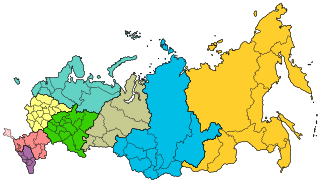
The federal districts are groupings of the federal subjects of Russia. Federal districts are not mentioned in the nation's constitution, and do not have competences of their own and do not manage regional affairs. They exist solely to monitor consistency between the federal and regional bodies of law, and ensuring governmental control over the civil service, judiciary, and federal agencies, operating in the regions.
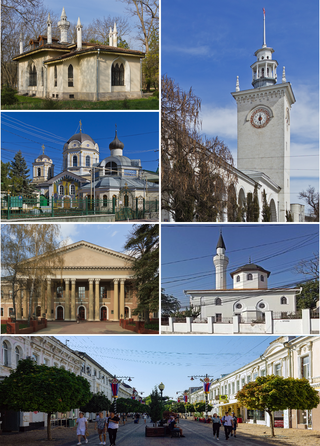
Simferopol is the second-largest city in the Crimean Peninsula. The city, along with the rest of Crimea, is internationally recognised as part of Ukraine, and is considered the capital of the Autonomous Republic of Crimea. However, it is under the de facto control of Russia, which annexed Crimea in 2014 and regards Simferopol as the capital of the Republic of Crimea. Simferopol is an important political, economic and transport hub of the peninsula, and serves as the administrative centre of both Simferopol Municipality and the surrounding Simferopol District.

Crimean Tatars or Crimeans are a Turkic ethnic group and nation who are an indigenous people of Crimea. The formation and ethnogenesis of Crimean Tatars occurred during the 13th–17th centuries, uniting Cumans, who appeared in Crimea in the 10th century, with other peoples who had inhabited Crimea since ancient times and gradually underwent Tatarization, including Greeks, Italians, Armenians, Goths, Sarmatians, and many others.

The Crimean Khanate, officially the Great Horde and Desht-i Kipchak and in old European historiography and geography known as Little Tartary, was a Crimean Tatar state existing from 1441 to 1783, the longest-lived of the Turkic khanates that succeeded the empire of the Golden Horde. Established by Hacı I Giray in 1441, it was regarded as the direct heir to the Golden Horde and to Desht-i-Kipchak.
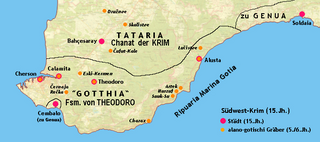
The Crimean Goths were Greuthungi-Gothic tribes who remained in the lands around the Black Sea, especially in Crimea. They were the longest-lasting of the Gothic communities. Their existence is well attested through the ages, though the exact period when they ceased to exist as a distinct culture is unknown; as with the Goths in general, they may have become diffused among the surrounding peoples. In his Fourth Turkish letter, Ogier Ghiselin de Busbecq (1522-1592) describes them as "a warlike people, who to this day inhabit many villages". However, in the 5th century, the Ostrogothic ruler Theodoric the Great failed to rouse Crimean Goths to support his 488-493 war in Italy. In medieval times it was customary to refer to a wide range of Germanic tribes as "Goths", so the exact ethnic nature of the Germanic peoples in Crimea is a subject of debate.

The transfer of the Crimean Oblast in the Soviet Union in 1954 was an administrative action of the Presidium of the Supreme Soviet of the Soviet Union that transferred the government of the Crimean Peninsula from the Russian SFSR to the Ukrainian SSR.

The recorded history of the Crimean Peninsula, historically known as Tauris, Taurica, and the Tauric Chersonese, begins around the 5th century BCE when several Greek colonies were established along its coast, the most important of which was Chersonesos near modern day Sevastopol, with Scythians and Tauri in the hinterland to the north. The southern coast gradually consolidated into the Bosporan Kingdom which was annexed by Pontus and then became a client kingdom of Rome. The south coast remained Greek in culture for almost two thousand years including under Roman successor states, the Byzantine Empire, the Empire of Trebizond, and the independent Principality of Theodoro. In the 13th century, some Crimean port cities were controlled by the Venetians and by the Genovese, but the interior was much less stable, enduring a long series of conquests and invasions. In the medieval period, it was partially conquered by Kievan Rus' whose prince Vladimir the Great was baptised at Sevastopol, which marked the beginning of the Christianization of Kievan Rus'. During the Mongol invasion of Europe, the north and centre of Crimea fell to the Mongol Golden Horde, and in the 1440s the Crimean Khanate formed out of the collapse of the horde but quite rapidly itself became subject to the Ottoman Empire, which also conquered the coastal areas which had kept independent of the Khanate. A major source of prosperity in these times was frequent raids into Russia for slaves.
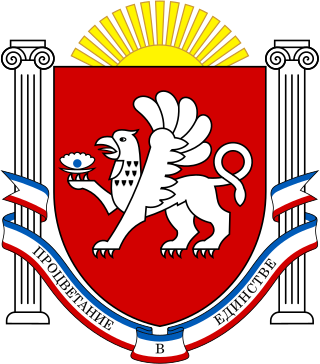
Verkhovna Rada of Crimea or the Supreme Council of Crimea, officially the Supreme Council of the Autonomous Republic of Crimea is a Ukrainian legislative body for the Autonomous Republic of Crimea before the annexation of Crimea by the Russian Federation in 2014.

The Crimean status referendum of 2014 was a disputed referendum on March 16, 2014, concerning the status of Crimea, in the Autonomous Republic of Crimea and the local government of Sevastopol after Russian forces seized control of Crimea. As the plebiscite was proclaimed, the Mejlis of the Crimean Tatar People called for a boycott of the referendum.

Sergey Valeryevich Aksyonov is a Russian politician serving, since 9 October 2014, as the Head of the Russian-annexed, but internationally unrecognised, Republic of Crimea.
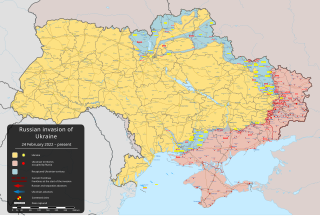
The Russo-Ukrainian War has been ongoing between Russia and Ukraine since February 2014. Following Ukraine's Revolution of Dignity, Russia annexed Crimea from Ukraine and supported pro-Russian separatists in the war in Donbas against Ukrainian government forces; fighting for the first eight years of the conflict also included naval incidents, cyberwarfare, and heightened political tensions. In February 2022, the conflict saw a major escalation as Russia launched a full-scale invasion of Ukraine.

The Autonomous Republic of Crimea, commonly known as Crimea, is an autonomous republic of Ukraine encompassing most of Crimea that was annexed by Russia in 2014. The Autonomous Republic of Crimea occupies most of the peninsula, while the City of Sevastopol occupies the rest.

In February and March 2014, Russia invaded and subsequently annexed the Crimean Peninsula from Ukraine. This event took place in the aftermath of the Revolution of Dignity and is part of the wider Russo-Ukrainian War.

The Republic of Crimea is an unrecognized federal subject (republic) of Russia, comprising most of the Crimean Peninsula, excluding Sevastopol. Its territory corresponds to the Autonomous Republic of Crimea, a de jure subdivision of Ukraine. Russia occupied and annexed the peninsula in 2014, although the annexation remains internationally unrecognized.
Politically, Crimea is recognized as part of Ukraine by almost all members of the international community. After the 2014 Ukrainian revolution, Russian troops were deployed to occupy Crimea and took over its government buildings. The official results of an internationally unrecognized referendum held during the occupation indicated support for Russian annexation, and the Russian-backed Crimean parliament unilaterally declared independence from Ukraine. Russia then annexed the region and created two federal subjects, the Republic of Crimea and Sevastopol. A United Nations General Assembly resolution declared the referendum invalid and affirmed the territorial integrity of Ukraine. Despite the lack of international recognition, the currency, tax, time zone and legal system are all operational under de facto Russian control. Ukraine has attempted to resolve the matter by filing litigation in multiple international criminal, environmental, political, and other courts.
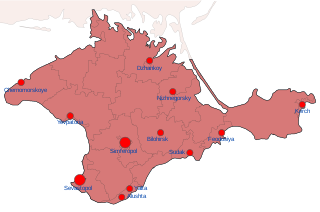
The Russian occupation of Crimea is an ongoing military occupation within Ukraine by the Russian Federation, which began on 20 February 2014 when the military-political, administrative, economic and social order of Russia was spread to the Autonomous Republic of Crimea and Sevastopol. The occupation of Crimea and Sevastopol was the beginning of the Russo-Ukrainian War.



















